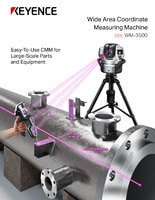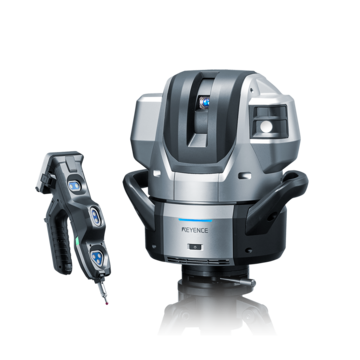CMM (Coordinate Measuring Machine)
How Do Laser Trackers Work?
Laser trackers are sophisticated instruments that have transformed the field of precision measurement. These devices provide reliable accuracy and versatility, making them irreplaceable tools for aerospace, automotive, manufacturing, and other industries. The following will look at what laser tracking is, how trackers work, and the common applications that fuel the use of this equipment.
What Are Laser Trackers?
Laser trackers are precision measuring devices used for high-accuracy dimensional measuring applications. By combining laser technology, encoders, and specialized software, these devices can determine the position of a target object in three-dimensional space.
The compact size and portability of laser tracking allow these units to be transported and set up wh ere the large measurement applications reside. This enables engineers and technicians to perform accurate measurements and alignments on-site at different job sites or manufacturing facilities. In addition, it minimizes the need for transporting the objects being measured to a dedicated measurement facility.
How Do Laser Trackers Work?
Laser trackers, for the most part, are relatively simple in their workings. They are built with a few main parts that help ensure accurate measurements and reliability. These components are the laser itself, the interferometer, the laser tracking software, and the target, also known as an SMR (Spherically Mounted Retroreflector). The tracker first sends the laser beam to a target that is held against whatever object is being measured. The laser beam’s light then reflects back to the tracker.
By measuring the difference between the emitted and received light waves, the laser tracker can precisely calculate the distance and position of the target. The main component that allows for that measurement to take place is the interferometer. This, in addition to the specialized metrology software, interprets the data and establishes the coordinates for the measurement.
The Proven Benefits of Laser Tracking
Laser tracking is being utilized daily by organizations worldwide for numerous reasons. This technology is advantageous over other measurement methods and will continue to be utilized for its benefits.
For one, laser tracking offers accurate measurements. This is often preferred over tape measures, calipers, and other measuring devices. Next, their portability and advancements in technology mean they can be installed and used nearly anywhere. Another benefit is the fact that trackers can offer real-time monitoring capabilities. What this allows is the ability to track the movement of objects over time, which is helpful for machine alignment and other uses.
Industries and Applications of Laser Tracking Systems
The versatility of laser trackers makes them useful in a wide range of applications. They help with alignment during assembly processes, part inspection, tool and mold building, calibrations, reverse engineering, and more. Because of this, many industries have realized the importance and benefits of implementing a laser tracking system into their operations.
Here are just a few industries and use cases where laser trackers excel:
- Aerospace Industry: Laser trackers play a crucial role in aerospace manufacturing and assembly processes. They are used for aligning and inspecting large aircraft components, ensuring precise positioning and dimensional accuracy. Laser trackers facilitate the assembly of complex structures such as wings, fuselages, and landing gear, contributing to improved aircraft performance and safety.
- Automotive Industry: In automotive manufacturing, laser trackers are utilized for quality control and dimensional inspection of vehicle components. They enable measurements of critical features, ensuring compliance with design specifications and tolerances. Laser trackers also aid in the alignment of robotic systems used in automotive assembly, optimizing production efficiency.
- Power Generation: Laser tracking finds application in the power generation industry for the alignment and maintenance of turbine components. They are instrumental in the positioning of rotor blades, shafts, and casings, which directly impacts the efficiency and reliability of power generation systems.
- Shipbuilding: Laser tracking is extensively employed in shipbuilding to support accurate construction and alignment of large ship structures. They assist in the positioning of hull sections, bulkheads, and other components, ensuring proper fit and alignment during assembly. Laser trackers contribute to the efficient construction of ships, reducing rework and enhancing overall productivity.
Besides these, many other industries also use laser tracking to save time and improve operations.
Advancements in Laser Tracker Technology
Over the years, laser tracker technology has evolved significantly, leading to enhanced accuracy, improved portability, and expanded measurement capabilities. Here are a few advancements that have helped laser trackers offer even more capabilities:
- Absolute Distance Measurement: Traditional laser trackers relied on interferometry techniques to measure the phase difference and calculate distances. However, recent advancements have introduced absolute distance measurement (ADM) technology. ADM uses a frequency-modulated continuous wave (FMCW) method, which enables direct distance measurements without the need for interference patterns. This technology eliminates the need for environmental compensation and improves measurement speed and accuracy.
- Wireless Connectivity: Another notable development in laser tracker technology is the integration of wireless connectivity. This innovation allows for seamless communication between the laser tracker and external devices such as laptops, tablets, or measurement software. Wireless connectivity eliminates the constraints of cables and enables greater flexibility in data collection and analysis, enhancing workflow efficiency.
As discussed, laser trackers are sophisticated instruments that leverage advanced measurement techniques to achieve amazing accuracy in distance and position measurements. With their ability to precisely capture three-dimensional data, laser trackers have become valuable . As technology continues to advance, we can expect further enhancements in laser tracker capabilities, opening up new possibilities for accurate and efficient measurement applications.
KEYENCE has been at the forefront of laser tracking/CMM technology. Our highly accurate, portable, and cost-friendly WM Series, Wide-Area CMM works like a laser tracker without having to overcome the obstacles of conventional laser trackers. Regardless of your industry and required application, our WM Series is sure to get the job done.
Ready to discuss your measurement needs? Reach out online or call us at 1-888-539-3623 today—we are happy to help.
Related Downloads

Brochure for the WM Series Wide-Area CMM. A portable setup with a wireless handheld probe that enables users measure large parts and equipment.
Related Products
Scroll

![WM Series Measurement / Application Examples [Fabrication Application Examples]](/img/asset/AS_116822_L.jpg)
![WM Series Measurement / Application Examples [In-Machine Measurement Examples]](/img/asset/AS_116821_L.jpg)
![WM Series Measurement / Application Examples [System Versatility Examples]](/img/asset/AS_116820_L.jpg)
